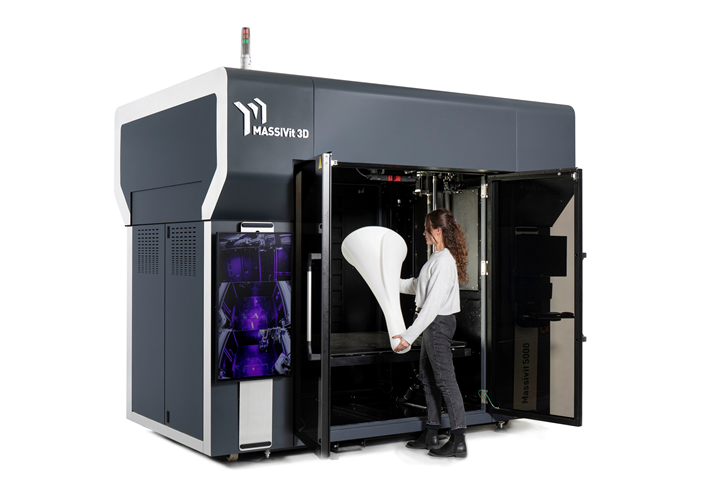Massivit 5000 3D printer expedites printed parts, increases workflow efficiency
The industrial-scale dual-material printer, with additional Industry 4.0 features, can produce full-scale parts, prototypes and molds 30 times the speed of competitive 3D printing.

Photo Credit: Massivit 3D Printing Technologies
Massivit 3D Printing Technologies Ltd. (Lod, Israel) reveals its industrial-grade Massivit 5000 3D printer, which the company claims offers 30 times the printing speed of competitive 3D printing. The industrial 3D printer is designed to expedite lead times for manufacturers across the rail, marine, automotive, defense, architecture, scenic fabrication and education sectors. It offers a build volume of 57" x 44" x 70" (145 cm x 111 cm x 180 cm) and is said to enable manufacturers to produce full-scale parts within a matter of hours.
The Massivit 5000 leverages Massivit 3D’s gel dispensing printing (GDP) technology that has, to date, been adopted in more than 40 countries. GDP incorporates the company’s photopolymer printing gel, Dimengel, that reportedly cures on-the-fly under ultraviolet (UV) light for high-speed production of large, complex parts with little-to-no required support structures.
The 5000 also features integrated slicing software, Massivit 3D says, for automated file preparation as well as a range of features designed to increase workflow efficiencies. Its dual-head printing mechanism makes it so two independent parts can be printed simultaneously, with the capability to use a different material on each head. The Massivit 5000 offers a range of print resolutions and modes including Variable Resolution mode. It also supports a wide range of purpose-specific printing materials. One of the most recently launched materials, Dim 20-FR, is a UL94-V0 compliant 3D printing thermoset gel, offering flame retardance.
Massivit 3D will be showcasing its new printer this week at RAPID + TCT show in Detroit, Mich., U.S.
Related Content
-
Jeep all-composite roof receivers achieve steel performance at low mass
Ultrashort carbon fiber/PPA replaces steel on rooftop brackets to hold Jeep soft tops, hardtops.
-
Plant tour: Albany Engineered Composites, Rochester, N.H., U.S.
Efficient, high-quality, well-controlled composites manufacturing at volume is the mantra for this 3D weaving specialist.
-
Large-format 3D printing enables toolless, rapid production for AUVs
Dive Technologies started by 3D printing prototypes of its composite autonomous underwater vehicles, but AM became the solution for customizable, toolless production.













